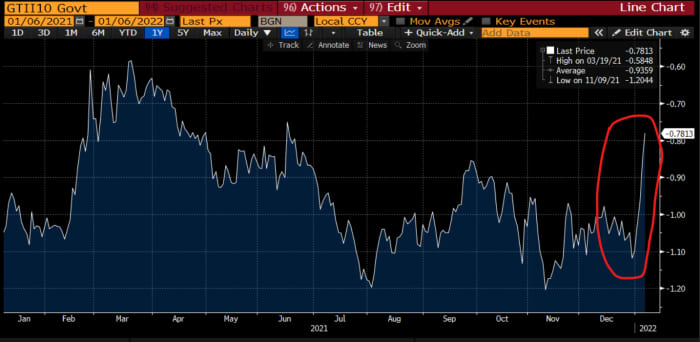‘Frankly, I’m surprised by how little yields moved’ since Fed minutes, with the jobs report looming

By Vivien Lou Chen
Federal Reserve Chairman Jerome Powell testifies in Washington last month. The central bank’s recent shift to a more aggressive policy stance is being called “The Great Powell Pivot.” ALEX WONG/GETTY IMAGES
In a somewhat sedate next-day reaction to the Federal Reserve’s December meeting minutes, bond traders took in the notion of a more aggressive Federal Reserve prepared to swiftly abandon easy policy.
The rather ho-hum response could be seen in Thursday’s modest Treasury selloff, which sent yields up by only a handful of basis points or less, as traders shifted into wait-and-see mode ahead of Friday’s U.S. jobs report for December. Treasury yields had already climbed by so much in the first few days of 2022, before the minutes were released, that this likely minimized what might have been an otherwise bigger impact of a now firmly-hawkish Fed, analysts said.
The takeaway is that the Fed’s minutes contained less new information than initially thought immediately after Wednesday’s release — which rocked financial markets, giving the tech-heavy Nasdaq Composite Index COMP, -0.77% its worst day in 11 months. The notion that officials are eyeing an earlier initial rate hike or faster pace of increases was already reflected in the Fed’s updated rate projections in December, analysts said. And while it was revealed that almost all participants agreed it would likely be appropriate to initiate balance-sheet runoff at some point — at least one official, Chris Waller, had already hinted as much last month.
Not even Thursday’s remarks by Federal Reserve Bank of St. Louis President Jim Bullard, who said the first rate hike could come as soon as March, caused much of a ripple in markets. Meanwhile, analysts continued to brace for the likelihood of higher Treasury yields in 2022.
“Frankly, I’m surprised by how little yields moved in response to the minutes or Bullard” on Thursday, said Chris Low, chief economist of FHN Financial. “The market hasn’t reacted with anything close to the kind of movement you might expect today, but the selloff yesterday was fast and sharp and compounded a significant selloff in the prior two weeks.”
Before the release of the minutes on Wednesday, investors had already significantly sold off Treasurys, giving the 10- and 30-year yields their biggest two-day gains since November 2020. The selloff was “primarily technically driven as people came back from vacations and took off hedges,” Low said via phone. Those hedges involved buying Treasurys into year-end last month, with a number of corporations preparing for huge bond sales at the start of 2022.
FHN Financial sees Treasury yields continuing to rise, with the 10-year rate TMUBMUSD10Y, 1.732% climbing to as high as 1.85% by year-end, the 30-year rate TMUBMUSD30Y, 2.085% at 1.92%, and the 5-year rate TMUBMUSD05Y, 1.492% at 1.7%, Low said.
‘In general, despite the perception of yesterday’s FOMC minutes, the nominal bond market’s reaction today has been very muted as we await tomorrow’s payroll number.’
One of the few places where substantial moves could still be seen in the rates market on Thursday was in the 10-year real or inflation-adjusted yield, which continued to rise from steeply negative levels. The 10-year real yield is “reacting very swiftly to the potential for a quicker timeline for not only rate liftoff, but balance sheet runoff,” said Gregory Faranello, head of U.S. rates at AmeriVet Securities in New York. And he says this move suggests that traders expect the Fed will be able to ultimately keep inflation under control.

“In general, despite the perception of yesterday’s FOMC minutes, the nominal bond market’s reaction today has been very muted as we await tomorrow’s payroll number,” Faranello said.
Faranello says the stage is now set for the 10-year yield to move back to 1.92%-1.95% this year, or level last seen in January 2020, from a current level around 1.73%. While most yields rose on Thursday, gains in shorter-end rates outpaced those in the longer end, flattening the yield curve in a sign of persisting concerns about the growth outlook.
Surprisingly, not even the notion of nearly unanimous support at the central bank for a reduction of the Fed’s more than $8 trillion balance sheet was enough to nudge the needle much in the market on Thursday. Such widespread support hadn’t been common knowledge prior to Wednesday, and a quick back-of-the-envelope calculation using some of the Fed’s own internal estimates suggests that such a balance-sheet runoff could have the same impact as four 25 basis point rate hikes per year, according to Low.
The market is currently in a wait-and-see mode ahead of Friday’s nonfarm payrolls report, which is expected to a show a gain of 422,000 versus 210,000 in November. “People are afraid of getting too far ahead of themselves and then having a number that falls short,” said Greg Staples, head of fixed income in North America for DWS Group DWS, -0.26% in New York.
He says DWS had already been positioned for a potentially hawkish Fed, by being underweight duration in government bonds at the end of 2021, and that “we’re going to continue to hold that position” on the expectation that yields will continue to climb. In addition, “we’re starting to get more concerned that this could precipitate more risk-off moves, like the one seen in March 2020″ at the onset of the COVID-19 pandemic.
He refers to the Fed’s recent dramatic turnabout from a dovish, or patient, stance on rates to hawkish one as “the Great Powell Pivot,” with many people still digesting what it will all mean.
https://www.marketwatch.com/story/frankly-im-surprised-by-how-little-yields-moved-since-fed-minutes-with-the-jobs-report-looming-11641503774




